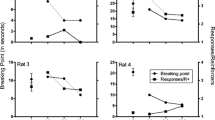Abstract
The effects of morphine, naloxone, and combinations of these drugs were examined in squirrel monkeys under shock-postponement schedules. In the absence of a lever press, shocks could be presented every 4s, and each response postponed shock for 20s. Acutely, morphine (0.10–3.00 mg/kg) produced not only overall response-rate decreases, but also increases in the number of shocks, whereas naloxone (0.10–30.00 mg/kg) had little effect on responding. When given in combination with morphine, several doses of naloxone antagonized the rate-reducing and shock-increasing effects of morphine. Daily administration of morphine resulted in a substantial decrease in the number of shocks received and a moderate attenuation of the rate-decreasing effects of morphine (tolerance). Lower doses substituted for the fixed daily dose resulted in a smaller effect on behavior than under acute administration. Naloxone given in combination with the daily morphine dose or substituted for the daily administration of morphine, produced effects similar to those seen prior to chronic drugging. Thus, behavioral effects of naloxone were not altered even though tolerance to morphine was observed. Larger doses of naloxone continued to antagonize the effects of morphine for at least 24h. No signs of physical dependence were noted when naloxone was administered or when administration of morphine ended.
Similar content being viewed by others
References
Blumberg J, Dayton HF (1973) Naloxone and related compounds. In: Kosterlitz HW, Collier HOJ, Villarreal JE (eds) Agonist and antagonist actions of narcotic drugs. McMillan, New York, pp 110–119
Boren JJ, Sidman M (1957) Maintenance of avoidance behavior with intermittent shocks. Can J Psychol 11:297–298
Brady LS, Holtzman SE (1980) Schedule-controlled behavior in the morphine-dependent and post-dependent rat. Psychopharmacology 70:11–18
Branch MN (1976) Environmental factors involved in the development of tolerance to behavioral effects of delta-9-tetrahydrocannabinol. Progress Report U.S. Army Medical Research and Development Command
Corfield-Sumner PK, Stolerman IP (1978) Behavioral tolerance. In: Blackman DE, Sanger DJ (eds) Contemporary research in behavioral pharmacology. Plenum, New York, pp 391–442
Dykstra LA, McMillan DE, Harris LS (1974) Antagonism of morphine by long acting narcotic antagonists. Psychopharmacologia 39: 151–162
Gellert VF, Holtzman SE (1978) Development and maintenance of morphine tolerance and dependence in the rat by scheduled access to morphine drinking solutions. J Pharmacol Exp Ther 205:536–548
Gellert VF, Sparber SB (1977) A comparison of the effects of naloxone upon body weight loss and suppression of fixed-ratio operant behavior in morphine-dependent rats. J Pharmacol Exp Ther 201:44–54
Hake DF, Azrin NH (1963) An apparatus for delivering pain shock to monkeys. J Exp Anal Behav 6:297–298
Holtzman SG (1974) Tolerance to the stimulant effects of morphine and pentazocine on avoidance responding in the rat. Psychopharmacologia 39:23–37
Holtzman SG (1976) Effects of morphine and narcotic antagonists on avoidance behavior of the squirrel monkey. J Pharmacol Exp Ther 196:145–155
Jaffe JH (1980) Drug addiction and abuse. In: Gilman AG, Goodman LS, Gilman A (eds) The pharmacological basis of therapeutics. McMillan, New York, pp 535–584
Leander JD, McMillan DE, Harris LS (1975) Effects of narcotic agonists and antagonists on scheduled-induced water and morphine ingestion. J Pharmacol Exp Ther 195:271–278
McMillan DE (1973) Effects of narcotics and narcotic antagonists on operant behavior. In: Braude MC, Harris LS, May EL, Smith JA, Villarreal JE (eds) Narcotic antagonists, advances in biochemical psychopharmacology. Raven, New York, pp 345–359
McMillan DE, Leander JD (1976) Effects of drugs on scheduledcontrolled behavior. In: Glick SD, Goldfarb J (eds) Behavioral pharmacology. CV Mosby, St. Louis, pp 85–139
Schuster CR, Dockens WS, Woods JH (1966) Behavioral variables affecting the development of amphetamine tolerance. Psychopharmacologia 9:170–182
Seevers MH, Daneau GA (1963) Physiological aspects of tolerance and physical dependence. In: Rout WS, Hofman EE (eds) Physiolocical pharmacology, vol 1. Academic, New York, pp 565–640
Sidman M (1953) Two temporal parameters of the maintenance of avoidance behavior by the white rat. J Comp Physiol Psychol 46:253–261
Snapper AG, Inglis G (1978) SKED software system: time shared super SKED, State Systems, Kalamazoo, MI
Snapper AG, Stephens KR, Cobez RI, Van Harren F (1976) The SKED software system: OS/8 and time share SKED, State Systems Kalamazoo, MI
Snapper AG, Stephens KR, Lee DM (1974) The SKED software system, State Systems Kalamazoo, MI
Teal JJ, Holtzman SG (1980) Stimulus effects of morphine in the monkey: Quantitative analysis of antagonism. Pharmacol Biochem Behav 12:587–593
Woods JH, Carney J (1978) Narcotic tolerance and operant behavior. In: Krasnergor N (ed) Behavioral tolerance: research and treatment implications. National Institute on Drug Abuse: Research Monograph Series 18, US Government Printing Office, Washington DC, pp 54–66
Young AM, Thompson T (1978) Effects, of naloxone on schedulecontrolled behavior in morphine-maintained pigeons. J Pharmacol Exp Ther 205:236–245
Author information
Authors and Affiliations
Rights and permissions
About this article
Cite this article
Dworkin, S.I., Branch, M.N. Behavioral effects of morphine and naloxone following chronic morphine administration. Psychopharmacology 77, 322–326 (1982). https://doi.org/10.1007/BF00432763
Received:
Accepted:
Issue Date:
DOI: https://doi.org/10.1007/BF00432763




